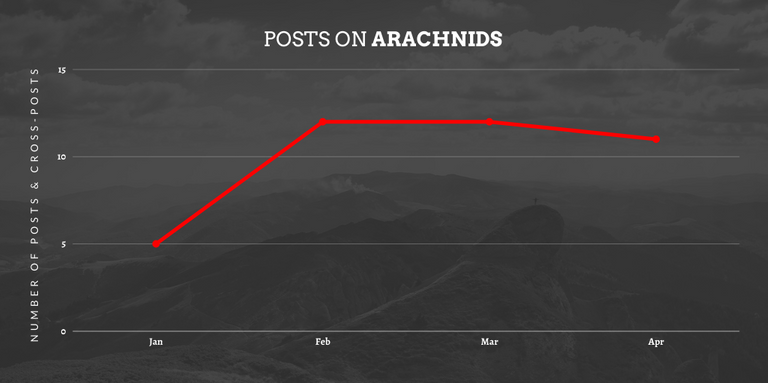The Arachnids Community celebrated its first quarter on the 7th of May 2022! And it warms my heart to see how active a community it has become with all the posts made in and cross-posted here. As promised in the ARCH Token announcement, this report will take a look at all things Arachnids including Arachnid of the Month for January, February, March, and April.

TOKEN
Since 30th March, funds accumulated toward the ARCH token goals are as follows:
- 41.508 HBD
- 11 WORKERBEE
- 4.10132614 SWAP.HIVE


COMMUNITY
Since its inception on 7th January 2022, the Arachnids Community has had 31 arachnid posts made straight to the community. An additional 9 posts were cross-posted, making it a total of 40 posts! This is a growth of 100%, which is expected since we just started.


ARACHNID OF THE MONTH
The spotlight moment! These are the posts that feature the best described, weirdest, most interesting, rarest, or extraordinary arachnid that has been published or cross-posted to the Arachnids Community that month. There have been so many posts about jumping spiders, in the family Saticidae. And it’s not a surprise at all, considering they make up the largest spider family!
JANUARY
For our first month on-chain, we didn’t receive many posts because we were still trying to gain attention by curating. It took a while, but we eventually got people to subscribe and post!

They're commonly known as bark jumping spiders, due to them preferring to nest under bark. And, with their long spineretts, it looks like they mimic bark spiders of the family Hersiliidae.
FEBRUARY
This month’s celebrity arachnid is Carl the Vinegaroon, by @sketch.and.jam. These arachnids are gentle and harmless as they have no venom glands. Those claws, however, can pinch and the vinegar-like acid they spray can be irritating to the skin and eyes.
Vinegaroons can be found in warm, tropical countries along and close to the equator, mainly in South-East Asia. However, only one species has been recorded in Africa despite this.

And this vinegaroon isn’t the only arachnid @sketch.and.jam has. A couple of tarantulas are part of the family as well!
MARCH
The arachnid of the month of March is by far the most confused, often being mistaken for spiders. At first glance, they look almost like one. It is, of course, the humble Harvestman, of the order Opilliones. Thanks to the macro-photography of @rosmadirazali, we get to see this beautiful arachnid in all her glory.
These arachnids are also harmless because they have no venom glands and they have no fangs. And they can be found on every continent except for Antarctica. They come in various sizes, shapes, and colours.

They are truly fascinating to watch, often being equipped with several defensive behaviours like bobbing and freezing, even producing a chemical stink. Some harvestmen have armour and weapons, too!
APRIL
April's arachnid spotlight falls on a cute little critter with a bright colour: @steampunkkaja 's Velvet Mite! Often confused for their parasitic cousin, velvet mites get little attention and harsh treatment. These mites are in the order Acariformes, and belong to the genus Trombidium.
 >
>
While many arachnids in the orders of Acariformes and Parasitiformes are parasitic and can carry disease, not all mites are "bad" or harmful to us. To plants, yes.

and help show support and encouragment toward arachnid posts on the HIVE blockchain.
@quochuy was the first to share a cross-post into the Arachnids Community with an awesome post about how he made a home for his pet jumping spider of the genus Servaea. The species is unknown and that is often the case with jumping spiders. For many, the only way to tell what species the spider is, is by looking at it under a microscope.